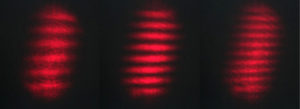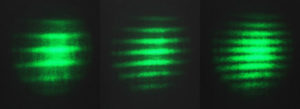Projection of Standing Waves
Projection of a standing ultrasonic wave in a liquid using divergent laser light
In the experiment, a standing ultrasonic wave is imaged in a liquid using divergent laser light. The dependence of the brightness modulation of the generated projection images on the wavelength of the light and the frequency of the ultrasonic wave is investigated and the speed of sound in the liquid (water) is determined.
Keywords: sound wavelength, speed of sound, standing and traveling wave, divergent monochromatic light, refractive indices, focal length of an optical lens
A standing ultrasound wave in a liquid can be imaged using divergent monochromatic light. The standing wave generates sound pressure differences in the liquid that repeat periodically along the sound axis. The resulting local density differences result in locally differing and periodically repeating refractive indices along the sound axis. When using monochromatic light, the projection of the standing wave therefore shows a light-dark modulation with periodically repeating brightness maxima that correspond to the density differences. The distance between these brightness maxima can be used to determine the sound wavelength and thus the speed of sound in the liquid.
The projection images of standing ultrasound waves in water obtained with green and red laser light (here at 2.8 MHz, 3.5 MHz and 4.5 MHz) show the expected reduction in the distance between the brightness maxima with increasing sound frequency. The difference between green and red lasers is due to the wavelength dependence of the refractive indices.

Red laser projection images
SCOPE OF DELIVERY:
| Item No. | Designation |
|---|---|
| 20100 | CW Generator SC600 |
| 20200 | Debye-Sears set |
| 20211 | Laser module (green) |
| 20230 | Projection lens |
| 20227 | Absorber mat |
ADDITIONAL EXPERIMENTS:
| PHY11 | Debye-Sears effect |
| PHY17 | Acousto-optical modulation of standing ultrasonic waves |




